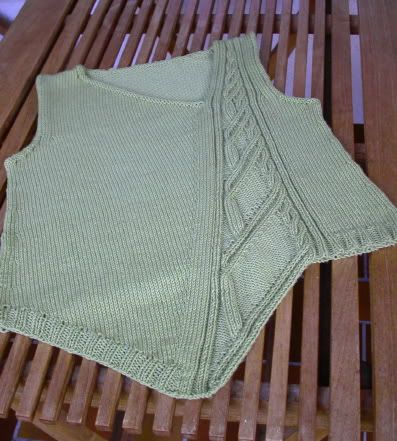tcknit asked how I translated the instructions for the swirled pentagon pullover for knitting in the round. There are many sources on the web, but here is how I did it.
[This post is also on
my regular blog. At that site, you will also find a long discussion about
sizing knitted pentagons for your gauge and your yarn.]
Usually, one would leave out the seam stitches when knitting in the round. But I left them in because, in my gauge and with my body dimensions, I needed the extra room the seam stitches would provide.
My gauge was 17 sts/4 in instead of 18. I wanted to make a 40" circumference sweater so I needed about 170 stitches all around. I used the instructions for the petite size, 82+82 = 164 stitches, which should make a sweater that was 39". I cast on 164 stitches, worked the 1x1 rib for an inch, and then switched to stockinette, adding some waist shaping along the way.
I knew that I wanted my sleeve to be slightly wider than 12", so I used the instructions for the size small (40") sweater. I hoped that I could ease the excess stitches into the stretchy yoke without any dimples.
Choosing to work with the written instructions was more than laziness. I could have customized the stitch count more to get exactly the right size. But I am fallible and know from prior experience that I can get the stitch count confused at the armhole shaping. Working with the written pattern stitch count gave me a safety net in case I lost track.
So I knit the sleeves and body pretty much exactly the way it was written, (except for waist shaping). I placed my underarm increases 2 stitches on either side of the join. I placed my waist shaping darts 20 stitches on either side of the center front and back. I used markers for the center front and back, sides and waist darts for the body and at the join for the sleeve.
When I got to the underarm shaping area, I bound off 3 stitches on either side of the sleeve join and the body's "side seams". Then I joined all 3 pieces and placed markers where the seams would have been (round 1). Then I knitted one row even which is equivalent to BO 3 at the beginning of the next 2 rows.
Where it said BO 2 at the beginning of the next 2 rows, I decreased one stitch at each end of the section.
2 stitches from each "seam", I made decorative decreases, pairing the S1, K1, PSSO decrease and the KSP decrease described
here.
On round 9, I divided for the center front and back Vs and knitted back and forth. Something I did not do, but should have done, was put the body join at a center front or back. That will make the conversion to the round easier. I placed the join at a side seam and the body and the sleeve row counts were offset by one for a little while. Not easy to keep track of.
I bound off the stitches at the top of the sleeve cap and the yoke as described in the pattern. I avoided the stair step by slipping the first stitch as described
here (and in many other places).
Here is the armpit area of the sweater after I sewed the bound off edges together.

A view of the decorative decreases. It might have looked better if I made the decreases only 1 stitch in from the "seams". Oh, well.

I used only one strand of the pink yarn when sewing the yoke to the sweater. Notice how the sweater is "rowed out" at the top? It is more obvious from the inside.

That's why I knit the sweater in the round. When knitting back and forth with inelastic cotton yarn, I simply cannot make my rows even. The sample above was knit using
combined knitting. With normal western purling, the difference would have been even greater.
Hope this long post doesn't bore too many people. That's why I didn't also post the instructions for
sizing knitted pentagons here.
























